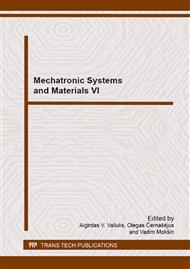[1]
H. Dyja, A. Maranda, R. Trębiński, Zastosowanie technologii wybuchowych w inżynierii materiałowej, Politechnika Częstochowska, Prace Naukowe, WMiIM, Seria Metalurgia Nr 20, Częstochowa, 2001 (in Polish).
Google Scholar
[2]
H. Dyja, S. Mróz, D. Rydz, Technologia i modelowanie procesów walcowania wyrobów bimetalowych, Seria Metalurgia Nr 33, Wydawnictwo WIPMiFS, 2003 (in Polish).
Google Scholar
[3]
S. Sawicki, S. Mróz, Analiza metod wytwarzania prętów bimetalowych stal – stal odporna na korozję, in: VII Międzynarodowa Konferencja Naukowa, Nowe Technologie i Osiągnięcia W Metalurgii i Inżynierii Materiałowej, 2006, Częstochowa. Materiały Konferencyjne Wydziału Inżynierii Procesowej Materiałowej i Fizyki Stosowanej, Seria Metalurgia Nr 48, 495–499 (in Polish).
DOI: 10.29119/1641-3466.2017.102.6
Google Scholar
[4]
L. Lesik, Proces walcowania prętów bimetalowych w wykrojach wydłużających, Politechnika Częstochowska, Prace Naukowe Wydziału Metalurgii i Inżynierii Materiałowej, Seria Metalurgia, Częstochowa, 1998 (in Polish).
DOI: 10.32730/imz.0137-9941.18.2.04
Google Scholar
[5]
H. Dyja, S. Mróz, A. Milenin, Theoretical and experimental analysis of the rolling process of bimetallic rods Cu-steel and Cu-Al, Journal of Materials Processing Technology 153, 154 (2004) 100–107.
DOI: 10.1016/j.jmatprotec.2004.04.186
Google Scholar
[6]
E. Łabuda, H. Dyja, P. Korczak, Changes of pass geometry of the system of oval and vertical oval stretching passes in the rolling process, Journal of Materials Processing Technology 80, 81 (1998) 361–364.
DOI: 10.1016/s0924-0136(98)00211-8
Google Scholar
[7]
L. N. Lesik, E. Łabuda, Possibilities of increasing the effectiveness of the system of oval and edge oval stretching passes, Zeszyty Naukowe Akademii Górniczo – Hutniczej im. St. Staszica, Metalurgia i Odlewnictwo 110 (1987) 39-43.
Google Scholar
[8]
S. Mróz S. et al., Rolling of Al-Cu Bimetallic Bars in Modified Elongating Grooves, Project No. N N508 583039, Final report, unpublished (2012) (in Polish).
DOI: 10.4028/www.scientific.net/ssp.220-221.875
Google Scholar
[9]
S. Mróz, H. Dyja, A. Milenin, Numeryczne modelowanie i weryfikacja doświadczalna procesu walcowania prętów bimetalowych, Hutnik – Wiadomości Hutnicze 5 (2004) 204-208 (in Polish).
DOI: 10.15199/24.2018.8.1
Google Scholar
[10]
S. Mróz, P. Szota, H. Dyja, Kawałek, Theoretical and experimental analysis of the Cu-Al bimetallic bar rolling process, Metalurgija (Metallurgy) 50(2) (2011) 85-88.
Google Scholar
[11]
A. A. Baranov, B. E. Nadvornyj, V.V. Pashynskij, Deformirovannye stalnye kompozicii, Stal 11 (1987) 44–48 (in Russian).
Google Scholar
[12]
A. A. Baranov, B. E. Nadvornyj, V. V. Pashynskij, Bimetallicheskaja katanka i provoloka s povyshennoj prochnostiu, Stal 4 (1988) 77–79 (in Russian).
Google Scholar


